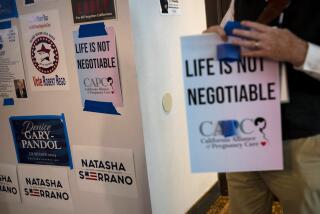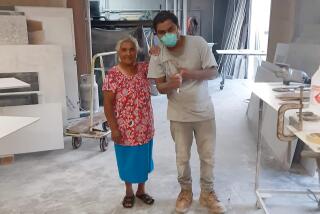Strife After Death
SAN RAFAEL, Calif. â The protests rang shrill enough to wake the dead.
After officials in this upscale Marin County town approved a downtown mortuaryâs request to add an on-site crematory, denizens of a popular bakery next door werenât exactly pleased.
âBake Bread, Not Bodies!â fumed one sign at a raucous City Council meeting in May. Another read: âOver My Dead Body.â
Neighbors winced at the image of a âcadaver incineratorâ that would run year-round, 16 hours a day. An Internet Web site created by critics warned of large bodies known as âstinkersâ that could take eight hours to burn, rather than the average 90 minutes. Area fliers showed a flaming skull and crossbones, asking: âCitizensâ last rites?â
As offbeat as this crematory showdown appears, such public theatrics are playing out nationwide.
By 2025, funeral industry studies suggest, nearly half of Americans will be cremated. Since 1999, the number of crematories has risen 20% -- from 1,468 to 1,825 last year. But in communities from Connecticut to California, residents say they donât want them near their homes, right beneath their noses.
Residents of Aiken, S.C., bought full-page newspaper ads to fight a crematory. In Seaside, Calif., near San Francisco, neighbors formed a group called A.S.H., for Allied Seaside Homeowners. Officials in Goodyear, Ariz., voted down a crematory after neighbors took to the streets.
Most critics worry about mercury from dental fillings, creepy odors and ash escaping from crematory smokestacks. They worry about a largely unregulated industry scandalized by such incidents as the Georgia facility that stockpiled 334 bodies rather than incinerate them. And last month a Lake Elsinore crematory operator pleaded guilty to 66 counts of mutilating corpses -- selling the body parts for research.
One complaint, related neither to health nor environment, tops them all. Call it the heebie-jeebie factor.
âThe outrage illustrates how people feel about their proximity to dead bodies,â said San Rafael Planning Commissioner John Alden. âMost donât like the idea that a corpse could leave a funeral home not inside a casket but through a smokestack.â
Residents monitor some crematories with video surveillance cameras and conduct regular, albeit unscientific, âsniff testsâ to gauge emissions.
Funeral directors say concerns about emissions and smells are vastly overstated. âWhen it comes to crematory fights, the respect for the dead goes right out the window,â said Jack Springer, executive director of the Cremation Assn. of North America. He has some advice for funeral directors planning to add an on-site crematory: Get ready for World War III.
âCrematories always lose the battle of public perception,â he says. âEven if a project wins, the sniping doesnât go away. One puff of smoke, some varnish from a burned casket, and theyâre on your case, saying, âItâs a crematory. Itâs got to be somebodyâs right leg.â â
After public pressure, the San Rafael City Council last month passed a law limiting crematories to industrial areas. Cremation advocates blame such moves on Americansâ innate fear of death.
âWeâre a death-denying society,â said Tom Simonson, past president of the Neptune Society of Northern California, which conducts 6,000 cremations a year. âPeople wonât walk past cemeteries or live near mortuaries. Some turn their backs on hearses from superstition. Itâs irrational. Because everybody dies.â
*
The nationâs first crematory was built in 1874, but about 90 years passed before most Americans would consider an alternative to burials in spit-polished caskets.
In 1963, Berkeley writer Jessica Mitford published âThe American Way of Death,â an expose of avarice in the funeral industry. She recommended cremation as a less-expensive alternative.
âThat book paved the way,â said Thomas Lynch, a Michigan funeral director, poet and author of such books as âThe Undertaking: Life Studies from the Dismal Trade.â âThatâs when cremation went from a statistical oddity to a growing norm.â
That same year, the Catholic Church relaxed its ban on cremations.
As Americans became more mobile, the neighborhood cemetery became less of a symbolic family plot. Said Springer: âIt no longer really matters where dear old Mom and Dad are buried, because the kids rarely come home; theyâre scattered across the world.â
In 1982, one in 10 Americans chose to be cremated. By 2002 the figure was one in four, with more than 676,000 cremations performed. By 2025, studies predict, 1.4 million -- or 45% of Americans -- will be cremated.
In 2002, California led the nation with 112,000 cremations, or 48% of those who died. Marin County has one of the stateâs highest cremation rates at 71%. California has 177 crematories.
Cremations have become so commonplace that itâs no longer surprising to learn that a neighbor has a parentâs ashes stored on the fireplace mantel. California has loosened laws on the disposal of cremated remains. Once limited to cemeteries, ashes now can be scattered on public lands with permission and in waterways, 500 yards from shore.
With costs starting at $650 for a basic cremation, the procedure remains less expensive than traditional burials, which average $5,500, not including gravesite and tombstone. Cremation costs also can be as high as burials depending on added services such as ceremonies and pricey urns.
By state law, a body must be housed in a combustible, rigid container before being placed in a cremation furnace, which normally is fueled by natural gas. A body need be embalmed only if mourners request a viewing before cremation.
Fired to 1,800 degrees, the furnace, or retort, reduces most bodies to 6 to 8 pounds of bone fragments. Air used in the process is reheated to 1,600 degrees in a second chamber to further eliminate particulates -- and then passes through a smokestack. The bones are then mixed in a blender. âWhat you get is a substance like sand, which is then placed in a temporary container or urn,â Springer said.
Both sides debate how many particulates pass through the smokestack. âIf the average cadaver weighs in at 150 pounds,â reads a Web site created in the San Rafael battle, âthen almost 250,000 pounds of matter per year will be sent skywards and redistributed on our town.â
Industry officials call that a clear exaggeration, saying that what gets released, if anything, are carbon monoxide, carbon dioxide and water vapors. Said Springer: âCompared to what goes into the atmosphere each day from car exhaust, this is truly a drop in the bucket.â
If operated properly, Springer maintains, crematories emit no smell because air used in the process is heated twice to void the source of would-be odors.
Indeed, in the grand scheme of industrial air pollution, crematories rank low on the alarm list, says Mary Roach, author of the best-selling âStiff: The Curious Lives of Human Cadavers.â She says the facilities emit half the particulates of a residential fireplace and as much nitrous oxide as a typical restaurant grill.
Of greater concern is mercury from dental fillings, which vaporizes and drifts into the atmosphere at a rate of a half-gram per cremation, according to a study conducted by the industry and the federal government. But at least one other study shows the rate to be much higher, at 3 grams per cremation.
âCompared to power plants and incinerated trash, the dental work of the dead generates a small fraction of the planetâs airborne mercury,â Roach said.
Still, some are considering alternatives to fire. Swedish researchers are experimenting with a process in which bodies are freeze-dried and composted in a bio-degradable coffin made of corn starch. Another procedure being studied, âtissue digestion,â would boil a body in a pressure cooker filled with lye.
The EPA has considered regulating emissions from crematories. And though the agency has yet to reach a decision, it says such emissions are comparatively low.
But federal officials say that, if regulated, the facilities could fall under Section 129 of the Clean Air Act, which covers âSolid Waste Incinerators.â And that would mean, explained Mark Merchant, an EPA spokesman in San Francisco, âthat what weâre incinerating in crematories is âsolid waste.â â
Added Roach: âThe EPA does not wish to stand accused of calling Americaâs dead loved ones âsolid waste.â â
*
Michael Gulasch knows the price of losing a crematory fight.
Itâs the noise: Stepping into his backyard in suburban Sunnyvale, he can hear the next-door retort built last year, a din âlike living next to a freeway.â
And the odor: âSome nights youâre overcome by a sickeningly sweet smell, like a bad perfume or a garbage can.â
And the dust: âI pick up dust with a white-glove test on my car or the buffet inside the house,â says the 52-year-old architect. âI donât know if itâs one dust or street dust. But I do know one thing: It wasnât there a year ago.â
His homeâs value has plummeted 25% since the 30-foot-high smokestack was raised next to his yard. Gulasch took a year off from his job to unsuccessfully battle the crematory project. He went to court, organized neighbors and picketed City Hall.
The loss depresses his family. âItâs devastating, especially to my kids,â he said, âto have someone violate your personal property rights so grossly.â
Ray Byrne sits on the other side of the crematory fence. He once owned two funeral homes and a crematory. But after losing a battle to add a crematory in San Jose, he left the business. âNobody wants a crematory,â he said. âBut we gotta build them someplace. And people wonder why the cost of dying is going up.â
Though laws once required crematories to be built in cemeteries, only two states -- New Jersey and Massachusetts -- still make that demand. Though Springer says there is less resistance to crematories in industrial areas, sometimes even they donât want them.
After a crematory was approved in Romeoville, an industrial town in Illinois, there were complaints about the crematoryâs odor. Said Springer: âAnd they hadnât even built it yet.â
In the end, says Lynch, Americans view cremation as an industrial process they do not want to see, hear or smell. Even some mourners avoid them. Though many crematories have viewing rooms, Lynch says they are rarely used.
âWe used to bury our treasure and burn our trash,â he said. âNow with landfills and crematories, we bury our trash and burn our bodies. Some people are having trouble getting used to that.â
More to Read
Sign up for Essential California
The most important California stories and recommendations in your inbox every morning.
You may occasionally receive promotional content from the Los Angeles Times.











